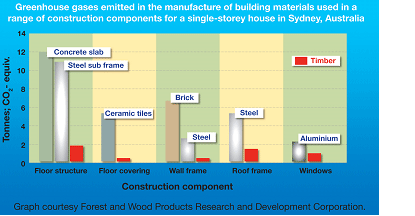Producing timber generates very few pollutants to air, water and land compared to other building products.
For example:
-
it takes eight times less energy to produce a tonne of timber than it does a tonne of steel and a staggering 46 times less energy than a tonne of aluminium?
-
a wood beam requires 10 times less energy to make than the equivalent steel beam.
-
wood window frames use 50 times less energy to make than aluminum window frames.
-
one study has indicated that timber can store up to 15 times the amount of carbon that is released during its manufacture.

The average timber house frame stores around 10 tonnes of carbon. In Queensland we build around 45,000 houses each year. If all of those houses were timber framed we could reduce our annual carbon footprint plus store an additional 450,000 tonnes of carbon.
Making the decision to use timber in construction will assist Australian in offsetting its overall greenhouse gas emissions. There are 12 steps to a successful timber purchasing, application and disposal strategy.
 |
Getting it right: a 12-step strategy for using timber in your building project.
|
Aside from timber’s environmental benefits, architects and building professionals agree that:
Timber is good insulator.
A 2.5 cm thick wooden board has better thermal resistance than a 11.4cm brick wall.
Timber is energy efficitent.
Wooden windows resist “cold-bridging’ and are easily repairable if damaged unlike windows made from some other materials.
Wood is beautiful.
Using timber and timber veneers adds beautiful design at reasonable cost.
Timber is durable.
Resistant to heat, frost, corrosion and pollution, moisture is the only factor that must be monitored.
Timber is safe.
Timber behaves predictably in fire. It creates a charred surface providing protection for the inner structure so that, depending on conditions, timber elements can remain intact and fully load bear during a fire.